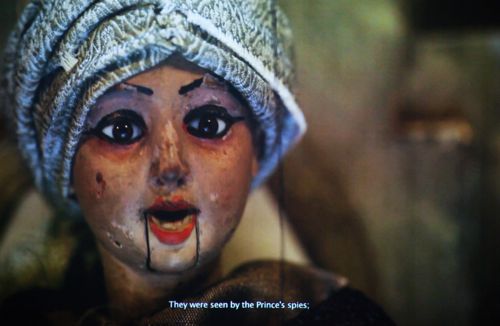If you are in London, don’t miss the Wael Shawky exhibition at Kensington Garden’s Serpentine Gallery.
There is a lot to like about this exhibition, which focuses on Shawky’s films, two part of his Cabaret Crusades series and his latest offering, which premiered at the exhibition, Al Araba Al Madfuna II (2013). Born and based in Cairo, Shawky melds different mediums and techniques to bring truly multi-layered historical reconstructions that force audiences to navigate the territory between truth and myth, stereotype and cliché.
In the Cabaret Crusades films, The Horror Show (2010) and The Path to Cairo (2012), Shawky uses marionettes to enact key events that occurred during the Crusades. The stories are told from the Middle Eastern perspective in classical Arabic. Full of detail, well-crafted backdrops, dazzling music and an involving storylines, both films are a great feat and reveal Shawky’s talents as a storyteller. The use of marionettes is also important: traditionally, storytelling with puppets (as was the case with Karagöz and Hacivat in Ottoman times) was used to narrate stories with strong moral messages.

The Horror Show (above) recounts events from the First Crusade and was shown in Istanbul as part of the 2011 Istanbul Biennial. The screenplay was taken from The Crusades Through Arab Eyes, written by the Lebanese writer Amin Maalouf in 1984. Maalouf collated a number of medieval Arabic texts to chronicle this period from the Muslim perspective, but also had input from Christian scholars.

The carved wooden marionettes used in this film, many of which are over 200 years old, come from the legendary Lupi collection in Turin. Shawky adapted the marionettes’ costumes and make-up specifically for the film. Choosing to use these exact puppets was also intentional: Shawky wanted to highlight that European-made figures are re-enacting the Crusades using Muslim stories.

‘Asphalt Flag 13’, 2010 and ‘Cabaret Crusades Flag 13’, 2010
The film is accompanied by a series of flags (above), created by the artist. Shawky based the designs on the real flags belonging to the Christian provinces that joined the First Crusade.

The Path to Cairo (above) follows on from the events depicted in The Horror Show and covers the 50-year period between the First and Second Crusades. The screenplay incorporates Maalouf’s text as well as the medieval French ballad ‘Le Chanson de Roland’, translated into Arabic. Because of this, the script is sung as often as it is spoken, adding an emotive edge.

The film looks considerably different as well. The backdrops were based on Muslim illuminated manuscripts to create a flattened, pop-up book effect. As for the marionettes, Shawky designed 110 especially for the film and these were produced by ceramicists in Aubagne, France, where there is a local industry focusing on this craft. The marionettes’ limbs and eyes are emphasised which allow for a wide range of movement and expressions. Some resemble humans, some animals and some hybrids of both. Shawky was inspired by the short story The J-B-R’s by the late Egyptian writer Mohamed Mustagab, which tells of a community living so closely with animals that its people begin morphing into them.

The film is accompanied by a room-sized glass cabinet of the marionettes used in the film. So wonderful, so detailed the marionettes that you may find yourself admiring the cabinet for as much time as you watch the films.

Everything from the detail of the skin to the costumes to the hair is painstakingly thought-out. The craftsmanship is astonishing, as the above image shows.

The above image shows another marionette, one of the hybrids described earlier, used to depict Alice, daughter of Baldwin II.


There is a also a collection of drawings inspired by the imagery in The Path to Cairo, which Shawky created especially for the exhibition. The drawings are marked by fantastical shapes, characters and landscapes, giving a glimpse into Shawky’s ingenious imagination. His interest in hybrids is again evident as the above drawings demonstrate, in which humans and animals grow body parts resembling Islamic architecture.

Shawky’s new film, Al Araba Al Madfuna II (above), is in a different flair. Filmed in monochrome and using children dressed as adults and with narration in adult voices (the deep, male baritone is particularly effective), the film re-tells two parables written by Mustagab. In The Offering, a whole village loses their inability to speak, while Horsemen Adore Perfume tells of the failed attempts of successive horsemen to overthrow a despotic ruler.

The combination of the two stories alongside the techniques Shawky employs is critical to understanding his work. ‘It is typical of Shawky to layer one imaginative gesture onto another so the spectator is left enlightened yet giddy by the pyramid of shifting expressions,’ writes Rachel Spence in the Financial Times. This is particularly true of this film. The marionettes are left behind and viewers are asked to let their own imaginations do the work.
The exhibition closes on February 9. Shawky’s video installations, ‘Dictums’, can be seen at the Lisson Gallery until March 8.
Photo credits:
Main image, images 2, 3, 7, 12 and 13: Wael Shawky, installation view, Serpentine Gallery, London (29 November 2013 – 9 February 2014) © 2013 Hugo Glendinning
Images 4, 10 and 11: taken by Victoria Khroundina at the exhibition
Images 5 and 6: Wael Shawky ‘Cabaret Crusades: The Path to Cairo’, 2012, video still, single channel HD-video, color, sound, dolby surround system, 59 min, courtesy Galerie Sfeir-Semler
© 2013 Wael Shawky
Images 8 and 9: Wael Shawky, ‘Cabaret Crusades: The Path to Cairo’, Figures 2 and 3, 2012, inkjet print on Crane Museo Max paper 62 x 42 cm (paper size), courtesy Galerie Sfeir-Semler
© 2013 Wael Shawky